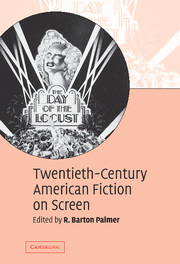Book contents
- Frontmatter
- Contents
- List of illustrations
- Notes on contributors
- Acknowledgments
- Introduction
- 1 Filming an unfinished novel: The Last Tycoon
- 2 The texts behind The Killers
- 3 The Day of the Locust: 1939 and 1975
- 4 Ship of Fools: from novel to film
- 5 Intruder in the Dust and the southern community
- 6 Dramatizing The Member of the Wedding
- 7 Film and narration: two versions of Lolita
- 8 World War II through the lens of Vietnam: adapting Slaughterhouse-Five to film
- 9 John Huston's Wise Blood
- 10 Genre and authorship in David Cronenberg's Naked Lunch
- 11 Screening Raymond Carver: Robert Altman's Short Cuts
- 12 The Color Purple: translating the African-American novel for Hollywood
- 13 The specter of history: filming memory in Beloved
- 14 Filming the spiritual landscape of James Jones's The Thin Red Line
- Filmography
- Index
- References
14 - Filming the spiritual landscape of James Jones's The Thin Red Line
Published online by Cambridge University Press: 12 January 2010
- Frontmatter
- Contents
- List of illustrations
- Notes on contributors
- Acknowledgments
- Introduction
- 1 Filming an unfinished novel: The Last Tycoon
- 2 The texts behind The Killers
- 3 The Day of the Locust: 1939 and 1975
- 4 Ship of Fools: from novel to film
- 5 Intruder in the Dust and the southern community
- 6 Dramatizing The Member of the Wedding
- 7 Film and narration: two versions of Lolita
- 8 World War II through the lens of Vietnam: adapting Slaughterhouse-Five to film
- 9 John Huston's Wise Blood
- 10 Genre and authorship in David Cronenberg's Naked Lunch
- 11 Screening Raymond Carver: Robert Altman's Short Cuts
- 12 The Color Purple: translating the African-American novel for Hollywood
- 13 The specter of history: filming memory in Beloved
- 14 Filming the spiritual landscape of James Jones's The Thin Red Line
- Filmography
- Index
- References
Summary
One of their number
On January 1, 1943, as a member of F Company, 27th Infantry Regiment of the 25th Infantry Division, Army private James Jones (1921–1977) landed on the island of Guadalcanal, which had been successfully invaded and partially occupied by the 1st Marine Division some months before. The Marines had suffered nearly 2,400 casualties in the bitter fight to take this outpost in the Solomons, from which the Japanese controlled the sea-lanes into northern Australia. The remaining Marine effectives were almost all suffering from malaria and other tropical diseases when they were withdrawn from a jungle battlefield that offered an obstacle almost as hostile to American arms as the enemy. The task facing the 25th (along with the Americal Division and units of the 2nd Marines) was to secure the rest of the island, whose airbase could then be used to project American power further into the ring of island fortresses that marked the forward advance of the Japanese offensive in the South Pacific.
The American command did not know at the time that the Japanese, hard pressed on land and in the surrounding waters, had determined to evacuate the majority of their troops, leaving behind only selected units, composed of men suffering desperately from disease and lack of food. These would fight a bitter rearguard action to the death in order to shield their retreating comrades.
- Type
- Chapter
- Information
- Twentieth-Century American Fiction on Screen , pp. 226 - 251Publisher: Cambridge University PressPrint publication year: 2007



